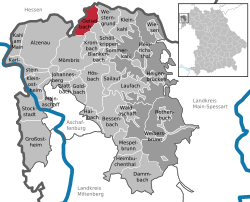History
In 1269, Geiselbach had its first documentary mention in a purchase agreement between the Seligenstadt Monastery and the Archbishopric of Mainz, between Abbot Conrad and Archbishop Werner.
There also exists an earlier document from 1250 in which was about a dispute between the brothers Friedrich and Heinrich von Rannenberg and Reinhard von Hanau about holdings and rights in Geiselbach.
After 1269, the Seligenstadt Monastery relinquished its rights in Geiselbach to the noble families of Büdingen, Hanau and Rannenberg and to the knight Erpho von Orb.
In 1278, the patrician from Gelnhausen Irmgard Ungefüge took over the Geiselbach Vogtei with the villages of Geiselbach, Omersbach and Hofstädten. In three documents from 25 May 1278 it was agreed between the Seligenstadt Abbey and Madam Irmgard that the Abbey could reacquire all rights from her in better times. Even before the turn of the century, in 1290, Sir Erpho von Orb was once again named the Vogt in Geiselbach.
The Seligenstadt Monastery held the lordship over Geiselbach until Secularization in 1802. Most of the villages of the upper Kahlgrund then passed to the Principality of Aschaffenburg. Geiselbach, on the other hand, as a Seligenstadt Monastery holding, passed into ownership of the Landgrave of Hesse, who moved the Vogtei administration from Geiselbach to Seligenstadt.
In 1811, the three villages were united with the Grand Ducal Hessian Amt in Alzenau, which itself became Bavarian in 1816.
In 1972 the formerly self-administering municipality of Omersbach was amalgamated with Geiselbach, while the municipality of Hofstädten, which had likewise belonged to the Vogtei of Geiselbach, passed to Schöllkrippen in 1978.
Coat of arms
The municipality’s arms might be described thus: Gules an uppercase A with crossbar on top in fess and cross stroke in chevron inverted Or among three mullets of six argent.
The municipality of Geiselbach was acquired in 1296 by the Seligenstadt Monastery from the Archbishopric of Mainz for an undisclosed price. It thereby belonged along with the two neighbouring villages of Hofstädten and Omersbach to the Vogtei of the Dreidörfer (“Three Villages”) over which the monastery managed to get the landlordship and the low jurisdiction through the acquisition. The big A (Abbatio) in the arms is the charge borne by the Seligenstadt Monastery and refers to the monastery’s lordship until Secularization in 1802. The three mullets (stars) symbolize the three-village parish. The tinctures silver and red are Electoral Mainz’s colours and recall Mainz’s lordship until 1803.
The arms have been borne since August 1967.
This page is based on this
Wikipedia article Text is available under the
CC BY-SA 4.0 license; additional terms may apply.
Images, videos and audio are available under their respective licenses.







